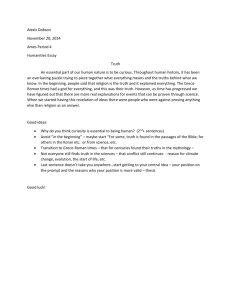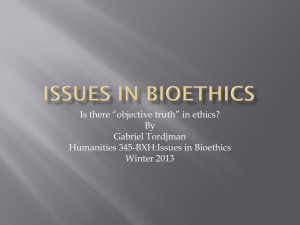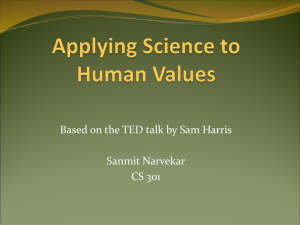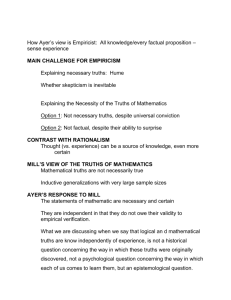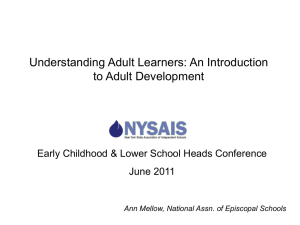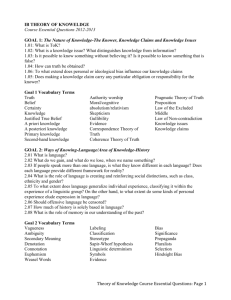Truth in Math, Art, Ethics: A Theory of Knowledge Essay
advertisement
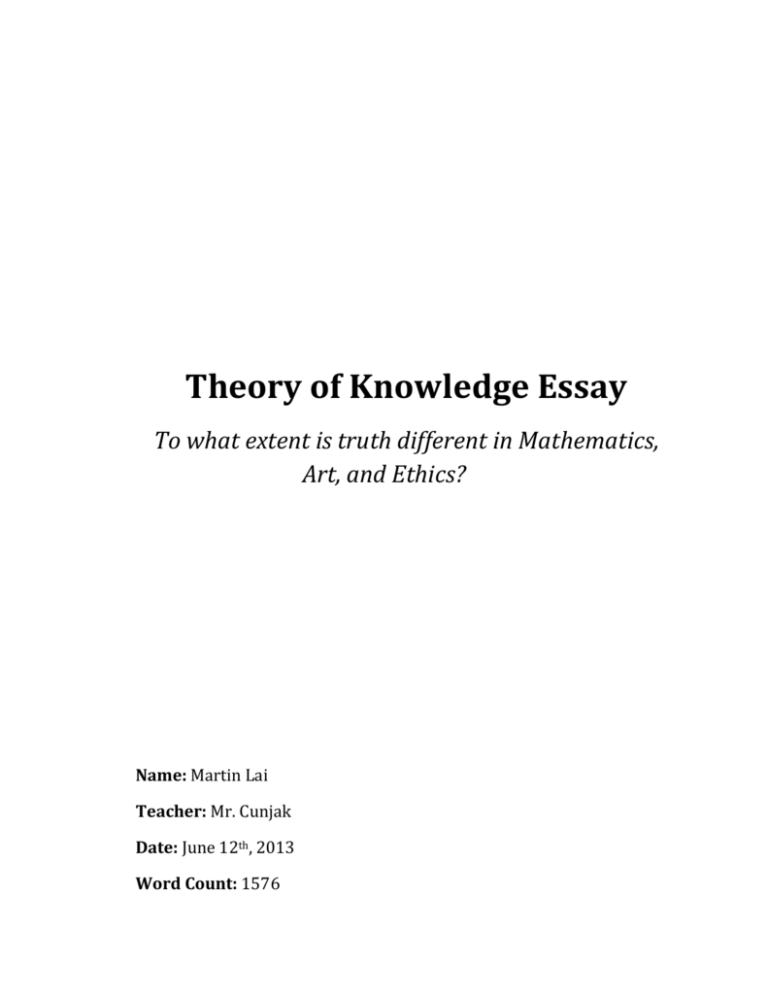
Theory of Knowledge Essay To what extent is truth different in Mathematics, Art, and Ethics? Name: Martin Lai Teacher: Mr. Cunjak Date: June 12th, 2013 Word Count: 1576 Truth is the ultimate goal that we strive for when we acquire and process the information we gain. It may be said that truth is a knowledge claim that can reflects fact or reality, and can be reasonably justified. However, this is just a single theory regarding truth. The concept of truth manifests in different forms and can be very subjective to the knower and the respective area of knowledge. It is essential to understand what the truth really entails and how we seek to attain it in our daily lives. Knowledge is a justified true belief; and thus it may be proposed that truth is an integral part of how we form our knowledge and make informed decisions. To be able to find the meaning of what truth really represents, it must be explored in three areas of knowledge: mathematics, arts, and ethics, and by comparing them, hope to draw a conclusion on what truth is and the implications of acquiring truth in these areas. Truth in mathematics is an area of knowledge based heavily in using reason as a way of knowing. Truth in math is to form an answer based on the information and guidelines we are given, and through a logical process justify our conjecture. Mathematics is based on fundamental principles proposed by mathematicians and accepted as truth by the community of knowers. These basic truths are then manipulated in the search for new knowledge. This suggests that truth follows strict existence in mathematics, since new truths must be based on pre-existing ones and everything must be justified and fit within the established paradigms. For example, in my calculus class, one of the first things taught to us was how to find the slope of a tangent, named the derivative, and the formula to do this was called ‘First Principles’. All of calculus is based on this one concept, and it was through reasoning that mathematicians were able to create new knowledge based on this idea. Whenever we do math questions, we are required to show all the work and the process is equally as important and the solution. The notion of truth being acquired through a systematic and logical process is suggested by the Coherence Theory of Truth, which proposes that if an argument follows valid deductive reasoning and the premises are true, then the conclusion must also be true. Therefore, in mathematics it can be said that there is a single set of truths that we can accept with certainty since they have been justified and fit a logical progression; the emotions and subjectivity of the knower do not influence this process and therefore plays no role in determining truth. However, an argument against this is that since all of this truth is based on a few fundamental principles, if these principles are disproved or a new set of principles are created, then we will have multiple sets of truths that are subjective to the specific principles they are based upon. For example, there is a Euclid math contest in our school each year which is named after a famous mathematician known as the father of geometry. Even though his claims were accepted as absolute truth for many centuries, a mathematician named Carl Gauss was able to work outside of Euclid’s fundamental framework and created a new set of truths for geometry. According to coherence theory, both are still true since they follow logical progressions, but approaching math from Gauss’ perspective would yield very different truths from Euclid’s. Despite this, since mathematical knowledge claims must be accepted by the community of knowers, it is more valid to suggest that we designate a single framework as truth and put others aside when dealing with mathematical knowledge claims. Art on the other hand, is presented in many different forms, with each piece of art being a unique representation of an idea or a sentiment, and therefore truth cannot be acquired by simply applying the same logical principles as in mathematics where everything follows a logical progression and is derived from other truths. Instead, truth is being able to evaluate the meaning or value of each piece of art as an individual creation. As opposed to in mathematics, the knower’s interpretation of art, the interpretation of the community of knowers, and the intention of the artist in presenting art must all be taken into account when dealing with art as a source of knowledge. An example of this is when I drew a picture of a heart in my biology class. I thought that I had drawn it very well and showed it to a classmate, who did not consider it as art and justified it by saying that the purpose of diagrams is to be informative rather than to invoke an emotional reaction. In this situation, truth was subjective to the classmate’s interpretation of the art. They did not consider the heart as art, since their logic told them that a diagram could not be considered art. However, as the artist my intention was to present the aesthetic qualities of the heart rather than draw attention to its scientific aspects. From this example, we can claim that truth is very subjective in art, and is linked to the perspective of the knower and there is no common truth when addressing the meaning or value of a piece of art. A counter claim against that notion is that while it is difficult to find a single truth in art, there are undoubtedly guidelines for addressing knowledge claims in art to allow us to compare our own truths with that of the truth accepted by the community of knowers. For example, in a wedding photo, the lighting of the photo, the depth and angle at which it was taken, and its ability to highlight the bride and groom’s smiling faces are all essential to the photographer when deciding if the photo is good or not, and by using these guidelines they are able to attain a truth that is not only personal but widely shared amongst other photographers as well. Ultimately however, even these guidelines can be subjective and be interpreted differently by others; there is little certainty that the truth gained by an individual will be shared exactly by others in the community of knowers due to the variations in which art can be interpreted. When examining truth in ethics, it is important to understand that there are several theories denoting what the moral code should be. This immediately brings forth the idea that truth is relative to the moral code of the knower, and in determining if a person’s decisions are morally correct a combination of reason and emotion as ways of knowing are required to reach a conclusion. For example, for one of my CAS projects I joined the cross country team. Another runner from our school had injured their leg but decided to run the race regardless. I did not want them to be left behind so I ran with them, but it quickly became apparent that we were in last place. At that moment I had to choose whether to run ahead or stay to motivate them. This was a difficult decision to make, as I reasoned that sportsmanship and friendship was important to me as well as being able to put my full effort into a race that I trained rigorously for. However, my emotion response of wanting to win made me run ahead and helped me make that tough decision concerning ethics. This example suggests that while we may have a general moral code, we manipulate it to suit the needs of specific situations, where reason and emotion are used to make that decision. This is similar to truth in art as there is no absolute truth, but rather truths that are relative to the perspective of the knower and involves the use of emotion to make a decision. The difference is that in ethics there is the added use of reasoning based on specific principles to acquire truth, similar to truth in mathematics. However, since our moral codes are relative and adaptable to our emotional response to a situation, completely objective truths are difficult, or even impossible to obtain. On the other hand, it can be argued that religious theories of ethics present a universal moral code and following them can lead to the creation of objective ethical truths. Although this is true, many extreme moral codes such as killing those who work on Sabbath in Christianity conflict with our ideals against killing, therefore nullifying the argument that we are able to follow these religious codes completely without introducing aspects of moral relativism. The concept of truth varies in these three areas of knowledge, but there are conclusions that can be drawn about the nature of truth. All of these areas share the notion that while there are guidelines to attaining an objective truth among a community of knowers, there is certainly no absolute truth. In most situations we manipulate our knowledge based on our own judgment. Truth in mathematics is more objective since it requires the justification of knowledge claims, while the arts and ethics focus more on the personal experience of the knower and involve using emotion as a way of knowing. Ultimately, as a community of knowers we seek to find objectivity and share common truths, though in each area of knowledge the criteria for what we accept as truth is inevitably subjective. Works Cited "Art and Truth." Art and Truth. N.p., n.d. Web. 13 June 2013. <http://www.unc.edu/~jbrady/Essays/arttruth.html>. "The Coherence Theory of Truth." (Stanford Encyclopedia of Philosophy). N.p., 3 Sept. 1996. Web. 13 June 2013. <http://plato.stanford.edu/entries/truthcoherence/>. Dombrowski, Eileen, Lena Rotenberg, Mimi Bick, and Richard Van De. Lagemaat. Theory of Knowledge: Course Companion. Oxford: Oxford UP, 2007. Print. "Moral Relativism." (Stanford Encyclopedia of Philosophy). N.p., 9 Feb. 2004. Web. 13 June 2013. <http://plato.stanford.edu/entries/moral-relativism/>.
